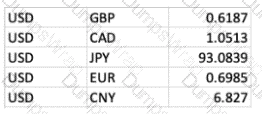SAP Certified Application Associate - SAP SuccessFactors Variable Pay 2H/2023 Questions and Answers
A public sector company would like to pay one business goal according to the following guidelines: If the company makes profits, employees get 100% of their target payout. If the company loses
$50,000, employees get 50% of their target payout. If the company loses $100,000 or more, nobody receives a payout. Finance provides administrators with the final amount on February 1 every year. How should your customer create this interpolated business goal?
The screenshot below is the entire currency conversion table. The functional currency of this customer is USD. Which currency view modes can be used with this table?

A customer does NOT want the basis to be prorated. In the employee history data file, what dates must the customer enter?
In which ways can the basis be configured in a non-EC integrated plan? Note: There are 2 correct answers to this question.
What is the difference between additive and multiplicative formulas for bonus calculation with respect to the impact of section weight, payout percent, and payout amount?
Which Variable Pay report shows employees that have less than the full plan year of eligibility?
Your client wants to change the label on a field in the Assignment Details level of their worksheet. Where could you make the change? Note: There are 2 correct answers to this question.
You are implementing an Employee Central-integrated Variable Pay template. The employee has 3 assignment records pulled from Employee Central, each with start and end dates within the bonus period, resulting in NO gaps or overlaps. What is the impact of the 3 assignment records on the payout?
How do you ensure that a planner enters an amount within a specific range?
Which of the following are standard criteria that can be used to create guidelines in variable pay? Note: There are 3 correct answers to this question.
What task can you complete in Configure Label Names and Visibility?
Which field-name attributes of a variable pay background element are reserved for a specific purpose? Note: There are 2 correct answers to this question.
Which field types can be added to the variable pay background section? Note: There are 3 correct answers to this question.
Your client has a performance process where employees can enter goals. The individual part of the employee's bonus is based on the performance against these goals – but not all of them. When going through the goal setting process, the employee and their manager will discuss whether or not a goal is "bonus relevant" – that is, the employee's attainment against that goal affects their bonus at the end of the year. What is the best way to set this up without administrative intervention?
Your customer wants to use its business units to assign goal achievements. What are the first steps to set up this requirement? Note: There are 2 correct answers to this question.
A customer has implemented Employee Central for most of their employees, but some employees remain on SAP ERP. What plan setting allows for the use of a single template for all employees?
Your customer has added a new employee to their Employee History. Based on the employee's data, they are eligible for the bonus plan, but when the customer tries to manually add them to a worksheet, they receive an error that the employee is unable to be added because they are ineligible. What might have been missed?
Your customer uses role-based permissions. The Variable Pay administrator imports the employee
history data file that contains the assignment history for all employees. What data is processed?
What does the Enable Guideline Optimization setting do? Note: There are 2 correct answers to this question.
From where can you pull fields to assign business goals to employees through the business goals import file?
You have an Employee Central client who wants to calculate the basis, based on employee-specific data. From which of the following areas can you get this data? Note: There are 2 correct answers to this question.
If the Starting Point for Manager Form Eligibility is set to "No employees are eligible", what actions can you take to include employees in the bonus plan? Note: There are 2 correct answers to this question.
Where do you set the display order of the business goals?
What information should be entered into the varPayProgramName column of the employee history data file?

